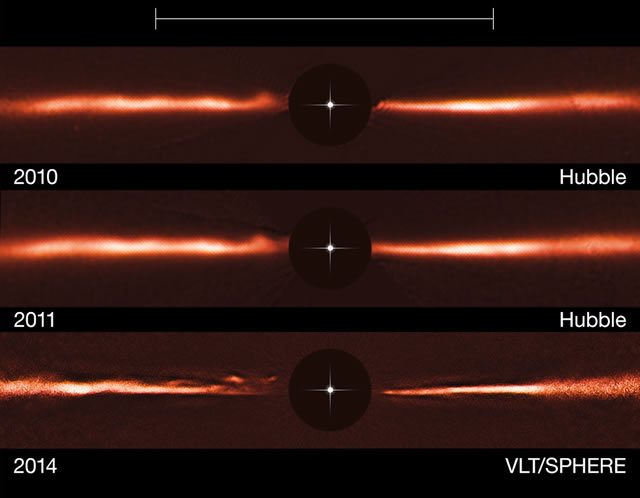
Credit: ESO, NASA & ESA
Increspature misteriose si rincorrono nel disco di formazione planetaria – Utilizzando immagini del VLT (Very Large Telescope) dell’ESO e del telescopio spaziale Hubble della NASA/ESA alcuni astronomi hanno scoperto strutture mai viste prima all’interno di un disco di polvere che circonda una stella vicina alla Terra. Le strutture ondulatorie e in movimento rapido nel disco della stella AU Microscopii non assomigliano a nulla che sia mai stato osservato prima e nemmeno previsto. L’orgine e la natura di queste strutture ci offrono un nuovo intrigo da esplorare. I risultati sono pubblicati sulla rivista Nature nel numero dell’8 ottobre 2015.
AU Microscopii, o AU Mic in breve, è una stella giovane e vicina a noi, circondata da un vasto detriti. Gli studi di questi dischi di detriti possono fornire indizi importanti su come i pianeti vengono formati proprio da questi dischi. Gli astronomi hanno cercato nel disco di AU Mic segni di grumi o strutture deformate poichè potrebbero indicare la presenza di possibili pianeti. Nel 2014 hanno usato per la loro ricerca le funzionalità di elevato contrasto di immagine del nuovo strumento dell’ESO SPHERE, installato sul telescopio VLT (Very Large Telescope) – e hanno scoperto qualcosa di molto inusuale. “Le nostre osservazioni hanno mostrato qualcosa di inaspettato”, spiega Anthony Boccaletti dell’Observatoire de Paris, Francia, primo autore dell’articolo. “Le immagini di SPHERE mostrano un insieme di strutture non spiegate nel disco che hanno una struttura ad arco o a onda, diverse da qualsiasi cosa che sia mai stata finora osservata”. Si vedono cinque archi ondulati a diverse distanze dalla stella, come increspature nell’acqua. Dopo aver trovato le strutture nei dati di SPHERE, l’equipe è tornata a analizzare le immagini precedenti del disco ottenute dal telescopio spaziale Hubble della NASA/ESA nel 2010 e 2011 per vedere se le strutture erano visibili. Non solo sono stati in grado di identificare le strutture nelle immagini precedenti di Hubble – hanno scoperto anche che sono cambiate nel tempo. Queste increspature cioè si muovono – e molto velocemente!
Fonte/Leggi tutto → ESO.org
Mysterious Ripples Found Racing Through Planet-forming Disc – Using images from ESO’s Very Large Telescope and the NASA/ESA Hubble Space Telescope, astronomers have discovered never-before-seen structures within a dusty disc surrounding a nearby star. The fast-moving wave-like features in the disc of the star AU Microscopii are unlike anything ever observed, or even predicted, before now. The origin and nature of these features present a new mystery for astronomers to explore. The results are published in the journal Nature on 8 October 2015.
AU Microscopii, or AU Mic for short, is a young, nearby star surrounded by a large disc of dust. Studies of such debris discs can provide valuable clues about how planets, which form from these discs, are created. Astronomers have been searching AU Mic’s disc for any signs of clumpy or warped features, as such signs might give away the location of possible planets. And in 2014 they used the more powerful high-contrast imaging capabilities of ESO’s newly installed SPHERE instrument, mounted on the Very Large Telescope for their search — and discovered something very unusual. “Our observations have shown something unexpected,” explains Anthony Boccaletti, LESIA (Observatoire de Paris/CNRS/UPMC/Paris-Diderot), France, and lead author on the paper. “The images from SPHERE show a set of unexplained features in the disc which have an arch-like, or wave-like, structure, unlike anything that has ever been observed before.” Five wave-like arches at different distances from the star show up in the new images, reminiscent of ripples in water. After spotting the features in the SPHERE data the team turned to earlier images of the disc taken by the NASA/ESA Hubble Space Telescope in 2010 and 2011 to see whether the features were also visible in these. They were not only able to identify the features on the earlier Hubble images — but they also discovered that they had changed over time. It turns out that these ripples are moving — and very fast!
Source/Continue reading → ESO.org





















